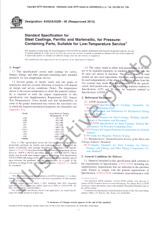We need your consent to use the individual data so that you can see information about your interests, among other things. Click "OK" to give your consent.
ASTM D8167/D8167M-23e1
Standard Test Method for In-Place Bulk Density of Soil and Soil-Aggregate by a Low-Activity Nuclear Method (Shallow Depth) (Includes all amendments and changes 5/9/2023).
Translate name
STANDARD published on 1.4.2023
The information about the standard:
Designation standards: ASTM D8167/D8167M-23e1
Publication date standards: 1.4.2023
SKU: NS-1142746
The number of pages: 9
Approximate weight : 27 g (0.06 lbs)
Country: American technical standard
Category: Technical standards ASTM
The category - similar standards:
Annotation of standard text ASTM D8167/D8167M-23e1 :
Keywords:
acceptance testing, bulk density, compaction test, construction control, dry density, field density, in-place density, low-activity, nuclear gauge, nuclear methods, quality control, soil density, wet density,, ICS Number Code 13.080.01 (Soil quality and pedology in general)
Additional information
| Significance and Use |
|
4.1?The test method described is useful as a rapid, nondestructive technique for in-place measurements of bulk density of soil and soil-aggregate. Test results may be used for the determination of dry density if the water content of the soil or soil-aggregate is determined by separate means, such as those methods described in Test Methods D2216, D4643, D4944, and D4959. 4.2?The test method is used for quality control and acceptance testing of compacted soil and soil-aggregate mixtures as used in construction and also for research and development. The nondestructive nature allows repetitive measurements at a single test location and statistical analysis of the results. 4.3?DensityThe fundamental assumptions inherent in the method is that Compton scattering is the dominant interaction and that the material is homogeneous. Note 3:?The quality of the result produced by this standard
test method is dependent on the competence of the personnel
performing it, and the suitability of the equipment and facilities
used. Agencies that meet the criteria of Practice D3740 are generally considered capable of
competent and objective testing/sampling/inspection, and the like.
Users of this standard are cautioned that compliance with Practice
D3740 does not in itself
assure reliable results. Reliable results depend on many factors;
Practice D3740 provides a
means of evaluating some of those factors.
|
| 1. Scope |
|
1.1?This test method describes the procedures for measuring in-place bulk density of soil and soil-aggregate using nuclear equipment with radioactive sources (hereafter referred to simply as gauges.) These gauges are distinct from those described in Test Method D6938 insofar as: 1.1.1?These gauges do not contain a system (nuclear or otherwise) for the determination of the water content of the material under measurement. 1.1.2?These gauges have photon yields sufficiently low as to require the inclusion of background radiation effects on the response during normal operation. 1.1.2.1?For the devices described in Test Method D6938, the contribution of gamma rays detected from the naturally-occurring radioisotopes in most soils (hereafter referred to as background) compared to the contribution of gamma rays used by the device to measure in-place bulk density is typically small enough to be negligible in terms of their effect on measurement accuracy. However, for these low-activity gauges, the gamma ray yield from the gauge is low enough that the background contribution from most soils compared to the contribution of gamma gays from the gauge is no longer negligible, and changes in this background can adversely affect the accuracy of the bulk density reading. 1.1.2.2?In order to compensate for potentially differing background contribution to low-activity gauge measurements at different test sites, a background reading must be taken in conjunction with gauge measurements obtained at a given test site. This background reading is utilized in the bulk density calculation performed by the gauge with the goal of minimizing these background effects on the density measurement accuracy. 1.2?For limitations see Section 5 on Interferences. 1.3?The bulk density of soil and soil-aggregate is measured by the attenuation of gamma radiation where the source is placed at a known depth up to 300 mm [12 in.] and the detector(s) remains on the surface (some gauges may reverse this orientation). 1.3.1?The bulk density of the test sample in mass per unit volume is calculated by comparing the detected rate of gamma radiation with previously established calibration data. 1.3.2?Neither the dry density nor the water content of the test sample is measured by this device. However, the results of this test can be used with the water content or water mass per unit volume value determined by alternative methods to determine the dry density of the test sample. 1.4?The gauge is calibrated to read the bulk density of soil or soil-aggregate. 1.5?All observed and calculated values shall conform to the guidelines for significant digits and rounding established in Practice D6026. 1.5.1?For purposes of comparing, a measured or calculated value(s) with specified limits, the measured or calculated value(s) shall be rounded to the nearest decimal or significant digits in the specified limits. 1.5.2?The procedures used to specify how data are collected/recorded and calculated in this standard are regarded as the industry standard. In addition, they are representative of the significant digits that should generally be retained. The procedures used do not consider material variation, purpose for obtaining the data, special purpose studies, or any considerations for the users objectives; and it is common practice to increase or reduce significant digits of reported data to commensurate with these considerations. It is beyond the scope of this standard to consider significant digits used in analysis methods for engineering design. 1.6?UnitsThe values stated in either SI units or inch-pound units are to be regarded separately as standard. The values stated in each system may not be exact equivalents; therefore, each system shall be used independently of the other. Combining values from the two systems may result in non-conformance with the standard. Reporting test results in units other than SI shall not be regarded as nonconformance with this standard. 1.7?This standard does not purport to address all of the safety concerns, if any, associated with its use. It is the responsibility of the user of this standard to establish appropriate safety, health, and environmental practices and determine the applicability of regulatory limitations prior to use. Note 1:?Nuclear density gauge manuals and reference materials,
as well as the gauge displays themselves, typically refer to bulk
density as wet density or WD.
Note 2:?The term bulk density is used throughout this
standard. This term has different definitions in Terminology
D653, depending on the
context of its use. For this standard, however, bulk density refers
to, as defined in Terminology D653, the total mass of partially
saturated or saturated soil or rock per unit total
volume.
1.8?This international standard was developed in accordance with internationally recognized principles on standardization established in the Decision on Principles for the Development of International Standards, Guides and Recommendations issued by the World Trade Organization Technical Barriers to Trade (TBT) Committee. |
We recommend:
Technical standards updating
Do you want to make sure you use only the valid technical standards?
We can offer you a solution which will provide you a monthly overview concerning the updating of standards which you use.
Would you like to know more? Look at this page.




 Cookies
Cookies
